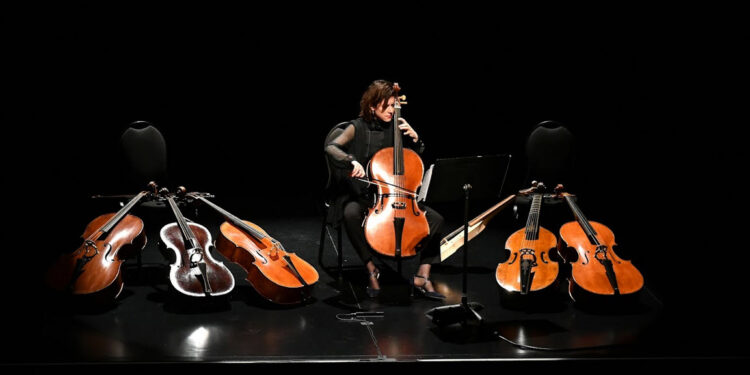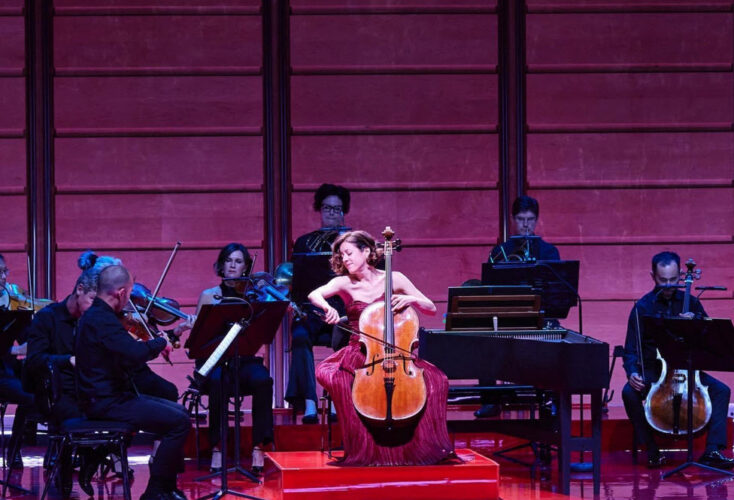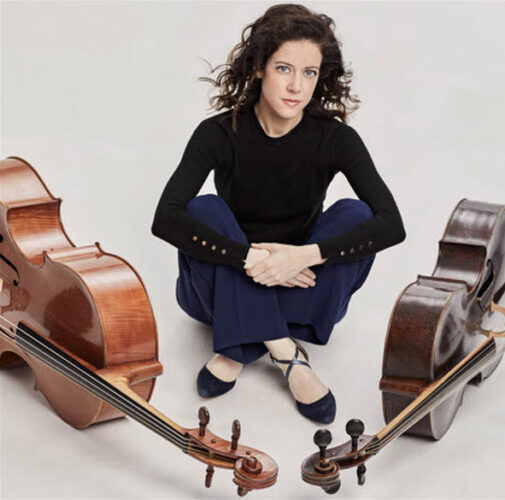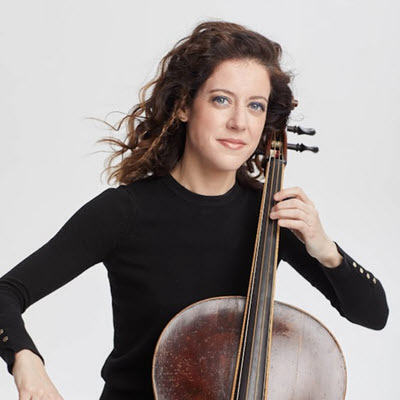With her every project, Elinor Frey asks: What’s the cello, and how do I want to play it?
‘She has such deep respect for her craft. There’s never a sense that things are good enough as they stand.’
(This article was first published in the May 2024 issue of EMAg, the Magazine of Early Music America.)

Ask Elinor Frey what it means to be galant, and you’re going to get a long and detailed answer. It’s not that the Seattle-born cellist is prone to long-windedness. On the contrary, conversations with her tend to be thoughtful, conversational, direct. Rather, it’s because few performers have spent as much time exploring the galant as Frey, who has made the style the subject of numerous recordings, performance projects, critical editions, and college seminars at McGill University and the Université de Montréal, where she teaches Baroque cello and performance practice.
“A galant person is someone who is well educated in manners, but is also very natural,” she says. “If there is a musical event, they would be able to pick up on some of what’s going on and be able to make comments. In turn, the composer or performer is anticipating the expectations of the listener — the two parties are participating actively. There’s a sense that they are up to date, sophisticated in fashion, and sophisticated in music. Nothing is dusty or old. It’s refined, witty, graceful, well-spoken, and well-mannered.” (These qualities might seem to contrast much of today’s boorish behavior, but more on that later.)
Frey — pronounced “Fry” — delivers her explanation with infectious enthusiasm, detectable even through the awkward medium of Zoom. Hers is a lively, vibrant characterization that contrasts with the dry, dismissive textbook definitions of the galant, usually entailing a few lazy sentences about musical simplicity and little else.
But it’s also a description that neatly encapsulates Frey’s own musical personality — sophisticated, eloquent, and, above all, deeply communicative.
“Elinor has this really joyous, loving characteristic that comes through in person, on stage, in discussing the way you want a musical phrase to go,” says Baroque violinist Edwin Huizinga, Frey’s friend and colleague of two decades. “She is open and real. She shares herself with her audience and her students in a way that’s very raw, which is why I think she has such an impact on younger generations of players. She has one of those inquisitive minds that never stops scratching the itch of discovery.”
When one speaks to Frey’s friends and colleagues, the words “curiosity” and “drive” form a constant refrain. She is intrepid, but also knows exactly what she wants. Musicologist, Baroque violinist, and conductor Dorian Bandy, her colleague at McGill who collaborated on a recent album of 17th-century violin sonatas, remarks that “Elinor has a vision and knows how to make it happen. She elevates everything she’s involved in.”

In addition to a busy teaching and performance schedule, Frey has recorded or appeared on a dozen CDs within a decade; picked up the five-string cello and viola da gamba; released critical editions of newly discovered music; re-invented her bow arm (twice); and is currently pursuing another degree in basso continuo from The Royal Conservatory of Brussels. This all might seem like a lot — and it is — but since the start of her career in early music, Frey has found the most success with a project-based approach: “Each project documents my exploration of ‘what’s the cello, and how do I want to play it?’”
It’s not the degrees or accolades that Frey seems most interested in, although she has plenty. Rather, through each project, she senses an opportunity to reinvent and refine her own voice as a musician and performer. Tracing the trajectory of her sizeable discography shows a clear transformation toward a musical presence that is increasingly free, articulate, and inventive.
Case(s)-in-point: Her most recent album, Dall’Abaco and the Art of Variation, offers 10 of her own Giuseppe Clemente Dall’Abaco-inspired variations, informed by the musical language of the galant, yet at the same time personal and unique. (In a glowing review, Gramophone cites one of Frey’s own variations: “she dispenses with the continuo in favour of double-stopped drones — an unexpected, and unexpectedly profound, twist.”)
“I’m participating in this galant cultural ideal: You play the piece with your own voice, especially if it’s something like a solo sonata, playing it in different versions so that the listeners can experience it newly,” she offers. “The tastes were educated — it’s not about doing the ‘right thing,’ it’s about avoiding prefabricated, ready-made templates.” And the goal is for “the performer to be so absorbed and immersed in the language that they can speak with more variety and more spontaneity.”
As for galant music itself, it’s not the only avenue that Frey has pursued in recent years, but it is one particularly well suited to her desire to assert her own voice. This is the aspect she feels is most often overlooked about the style, which continues to capture her attention in new and unexpected ways.
“The more I play it, and the more I listen, the more I’ve learned to appreciate it. It’s a medium that communicates a lot of emotion for me. Even though a lot of galant music is purposefully ‘entertaining,’ trivializing it would be like saying anything that entertains or relaxes or delights is meaningless. I wake up in the morning to enjoy things, like coffee, because it’s made of simple ingredients. It doesn’t bore me.”
Or, put more concisely, “I just freakin’ love this stuff!”
A ‘true’ Baroque cellist
Frey began as a modern cellist, but historical performance had always been in the vicinity. Her aunt was the legendary medievalist and singer Barbara Thornton, who founded the pioneering ensemble Sequentia alongside partner Benjamin Bagby, whom Frey describes as “still an uncle to me even though my aunt died…We chat on WhatsApp all the time.” (The official description of Early Music America’s biennial Barbara Thornton Scholarship, echoing her spirit, cites “an outstanding and highly motivated — and possibly unconventional — young performer of Medieval music.”)
Frey’s own interest in historical performance began to blossom while she was completing a doctorate at McGill, fueled by a 2010 Fulbright scholarship in Italy that allowed her to immerse herself in the culture of early music: “I started to follow some other instincts — my total amazement by history, the cello itself. I started to understand how these things feel so creative. It felt like new, but with old music.”
In Italy, Frey studied with cellist, musicologist, and longtime mentor Marc Vanscheeuwijck, who recalls her “incredibly inquisitive mind and passion of in-depth exploration.” Vanscheeuwijck remarks that, whereas most historically informed cellists all but ignore “the vast diversity in sizes and types of instruments” with regard to number of strings, tunings, bows, and bow holds, it is “quite different with Elinor. She acquired several instruments, and uses the appropriate ones, their tunings, bow holds, etc., while literally relearning the various practices of the Baroque era. In that sense, she’s one of the very few ‘true’ Baroque cellists in North America.”
‘One of my main interests is to follow my intuition, to see how constant change brings about new music and new ways of playing.’
“Who I am in relation to music and my instrument is changing all the time,” Frey says. “One of my main interests is to follow my intuition, to see how constant change brings about new music and new ways of playing. How it reproduces the past or tries to differ from the past. That’s why I have lots of energy — because I’m constantly discovering through change and growth.”

It’s a recipe that has served her well. Starting in 2013 and continuing at a steady clip, Frey’s first recordings on the Baroque and five-string cello began to emerge, proof that she had already become a formidable player over the course of a few years. Her fifth Baroque CD and the first dedicated wholly to Dall’Abaco — whose music she describes as “the work of my life” — won France’s coveted Diapason d’Or in 2020. Things were going rather nicely.
Then she switched it up.
An encounter with a sketch depicting the 18th-century cellist and composer Antonio Vandini, courtesy of Vanscheeuwijck, sparked an interesting idea: Why not try to play cello with an underhand bow grip, as did early cellists? Taking it out for a spin was one thing, but Frey was intent on mastering the technique. She acquired another grant to study in Italy, recalling, “For two months, I went through that really awkward phase of having less control. I found that I had to let go of my bow hold in order to become a better cellist.” For a subsequent recording released in 2021, Antonio Vandini: Complete Works, she used underhand for roughly half of the album. The technique also inspired her to learn the viola da gamba, on which she now performs and records regularly.
By the time she recorded her second Dall’Abaco CD, in 2022, Frey again felt that she needed to re-invent her approach in order to cultivate the sound she envisioned: “That was the second time that I had to lose my bow hold, which again felt like losing my authority and control in order to change my playing.” Her bow grip now rests lower on the stick than for most Baroque cellists, an adjustment she describes as transformative. If her most recent recordings are any indication, the change is paying dividends: She draws a sound that’s more varied, nuanced, and colorful than ever.
“Over the past five years,” says her McGill colleague Bandy, “I’ve watched Elinor re-invent herself over and over. She’s constantly trying to learn something new and expand her abilities. She’s always trying to be better, and that’s something I find really admirable and inspiring. She has such deep respect for her craft. There’s never a sense that things are ‘good enough’ as they stand.”
Bad manners, the anti-galant
Frey greatly prefers talking about music over talking about herself. Yet, in a handful of social media posts over the last few years, she has been outspoken about encounters with subtle and not-so-subtle sexist behavior, particularly when it has interfered with her performances.
One anecdote has a man — a total stranger — explaining to Frey after a performance that her music was “silly” and “incomprehensible,” although he enjoyed the few pieces in which she was joined by male colleagues. In another post, a stagehand with an obvious crush develops a hero complex. When she asks that he not turn down the AC any further, he instead takes it upon himself to shut it off completely. As a result, under the unmitigated heat of the stage lights, Frey has to constantly re-tune her numerous gut-strung instruments — seven for that particular performance. Well-meaning, Frey allows, but utterly and unnecessarily exhausting.

Reactions to her posts have been largely supportive, both publicly and in private, although anyone who engages with the internet will be familiar with denialists and trolls who refuse to believe that such problems are, in fact, problems. They might see it as “not a big deal,” or will perhaps feel that Frey’s motivations are self-serving, ignoring the fact that they come with considerable personal and professional risks, even for someone at the top of her field.
Frey also recognizes that there will be progressive-minded people who feel that talk of so-called “microaggressions” distracts from more overt forms of sexism — she lives, after all, in the city where infamous conductor Charles Dutoit, repeatedly and credibly accused of sexual assault, reigned for decades with relative impunity. But Frey believes that dismantling the patriarchy has to occur at multiple levels, especially when the more subtle presentations are what most often impact her ability to work.
“If you are going through your day, on stage doing something demanding emotionally and physically, to have that extra drain is just such a bummer. Getting at the subtlety is important, so I try to show a range of things. Someone reaching toward my bra to stuff in a $20 bill is a totally obvious violation — this happened! But somebody who was not carefully listening, demanding a bit too much attention, or being insulting as a way of trying to get close to you. These are the more subtle neuroses of patriarchal thinking.”
‘I want to be open-hearted, vulnerable, enthusiastic, passionate. I want to connect to people…It frustrates me that this system makes me on guard and less myself.’
Frey takes a wide and nuanced view of the patriarchy and what it constitutes. For her, it’s a question of “power, freedom, safety, and creative expression that extends far beyond dichotomies like men vs. women. I am constantly trying to expand my view.”
As someone deeply invested in communicating musically, steeped in repertoire reliant on the idea of connecting with audiences — she even wonders if there is something about Baroque music that somehow heightens this dynamic — Frey observes that men will sometimes confuse her openness as a performer with a kind of false, parasocial relationship:
“There’s a kind of brain fog that happens when a person stops behaving appropriately. They’ve been conditioned by the world around them to freak out when somebody has what they interpret as a beautiful or powerful energy, or a lot of love, or a lot of openness. And, unfortunately, the result is that I have to kind of shrink and shut down. I don’t like that for myself. I want to be open-hearted, vulnerable, enthusiastic, passionate. I want to connect to people, including men, including strangers. It frustrates me that this system makes me on guard and less myself. I know this is an experience among musicians of all sorts of identities.”
At no point in our Zoom conversations does she seem to relish this task, but Frey feels the need to share these stories to create a more positive working environment for herself, her colleagues, and her students. When she posts online, she knows many people won’t be swayed one way or another. But they “might just move an inch in the right direction. In my opinion, that’s a positive impact.”
It’s a moral imperative, but it’s also something she sees as necessary to protect her voice as a performer — again and again, she consistently comes back to the music. While she will continue to speak out, Frey ultimately hopes that the focus will remain on her work: “My energy goes to Dall’Abaco.”
Unsurprisingly, when asked about a musical “bucket list,” Frey zeroes in not on venues or awards, but on repertoire and skills.
“There are always certain technical things I want to improve on…” She trails off and grins, adding, “I don’t want to reveal my weaknesses. As for repertoire, I think it will come organically. Five years ago, I couldn’t have predicted everything that’s happened since. I don’t know what new things are going to lead to. New repertoire, new approaches — all I know is that my eyes are open. I’m always looking.”
And when it comes to discovering new aspects of playing, Frey shows no sign of stopping. Her recent enrollment in a specialized graduate program in basso continuo performance practice at the Royal Conservatory of Brussels demonstrates, among other things, a total refusal to rest on her laurels.
“I’m a better teacher and a better performer when I’m learning. I think of the cello a little bit like tennis — it’s more interesting to have a coach. I’m trying to reach the highest level that is possible for me and I can’t do that alone. I don’t want to sit at McGill University and say, ‘Well, I have some success and so I’ll take what I have.’ I think it’s irresponsible.”
Put another way, as the 80-year-old Pablo Casals famously replied when asked why he continued to practice, “Because I think I am making progress.”
Jacob Jahiel is a writer and viola da gamba player living in Baltimore.

